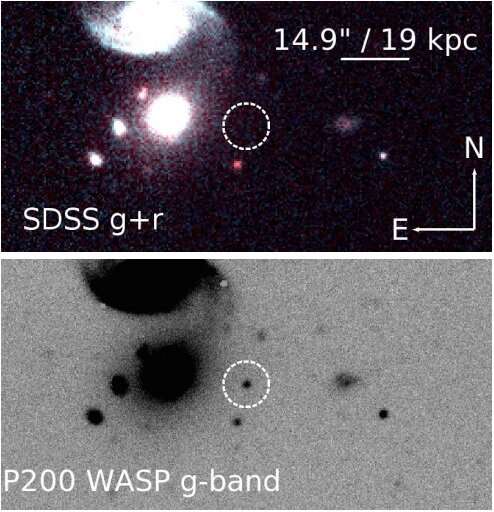January 14, 2019 report
Supernova SN 2018byg triggered by a helium-shell double detonation, study finds

Astronomers have recently conducted photometric and spectroscopic observations of SN 2018byg, a peculiar Type Ia supernova. Results of these observations, presented in a paper published January 3 on the arXiv pre-print server, suggest that this cosmic explosion was caused by double detonation of a massive helium shell.
Supernovae (SNe) are energetic stellar explosions basically classified as Type I and Type II, depending on their light curves and nature of their spectra. Type I SNe are divided into three subclasses: Ia, Ib and Ic. Type Ia SNe are believed to be the result of the explosion of a carbon-oxygen white dwarf in a binary as it goes over the so-called Chandrasehkar limit (1.4 solar masses), either due to accretion from a donor or mergers.
First spotted on May 4, 2018, SN 2018byg (also known as ZTF 18aaqeasu or ATLAS 18pqq) is one of many interesting Type Ia SNe. A team of astronomers led by Kishalay De of California Institute of Technology (Caltech) has carried out an observational campaign of this supernova using various ground-based telescopes and spacecraft. These observations provided important insights on the origin of this stellar explosion.
"In this paper, we present observations of ZTF 18aaqeasu, a peculiar Type I SN that exhibits remarkable similarities to expected signatures of a He-shell double detonation on a white dwarf," the researchers wrote in the paper.
As noted in the study, De and colleagues assume that in the case of SN 2018byg, the explosion was most likely triggered by a detonation of a helium-shell on a white dwarf. In particular, observations show that the outer layers of the ejecta are unusually rich in iron (Fe) group elements. This, according to the astronomers, could indicate a decay of radioactive elements in the outermost ejecta for an explosion powered by a helium-shell detonation.
Furthermore, the study found that photometric and nucleosynthetic properties of SN 2018byg are several similarities to sub-luminous Type Ia SNe. However, its peak photospheric spectra have extremely strong line blanketing features and red colors, what is unusual for Type Ia SNe.
In order to explain these properties of SN 2018byg, the researchers compared the data to various models. They found that the most plausible hypothesis explaining SN 2018byg's peculiarity is the detonation of a massive (around 0.15 solar masses) helium-shell on a white dwarf with a mass of about 0.75 solar masses.
"We show that the peculiar properties of ZTF 18aaqeasu are consistent with the detonation of a massive (≈ 0.15 M) helium shell on a sub-Chandrasekhar mass (≈ 0.75 M) white dwarf after including mixing of ≈ 0.2 M of material in the outer ejecta," the authors of the paper concluded.
The researchers added that the properties and origin of SN 2018byg make this supernova one of its kind. Their study suggests that helium-shell double detonations must be intrinsically rare in the population of thermonuclear supernovae.
More information: Kishalay De et al. ZTF 18aaqeasu (SN 2018byg): A Massive Helium-shell Double Detonation on a Sub-Chandrasekhar Mass White Dwarf. arXiv:1901.00874 [astro-ph.HE]. arxiv.org/abs/1901.00874
© 2019 Science X Network





















